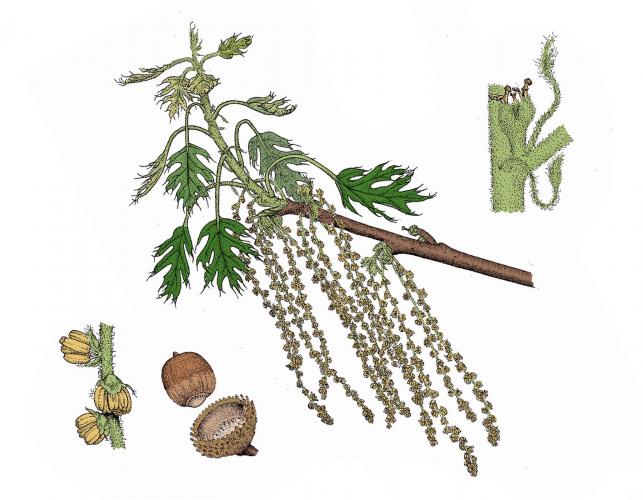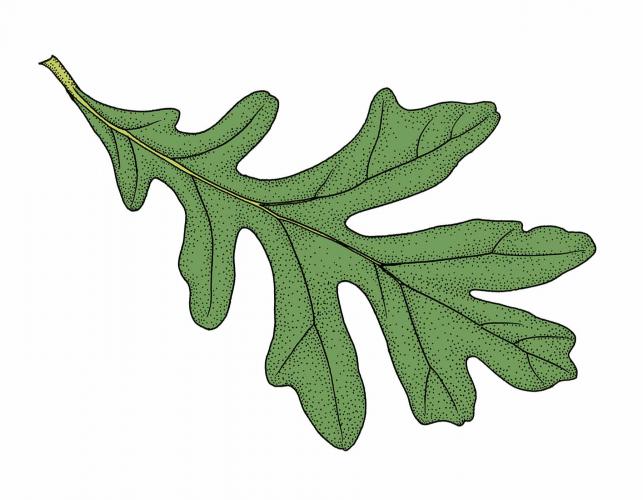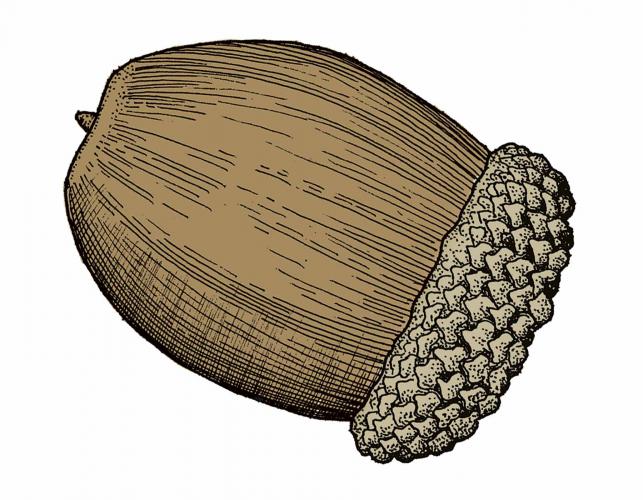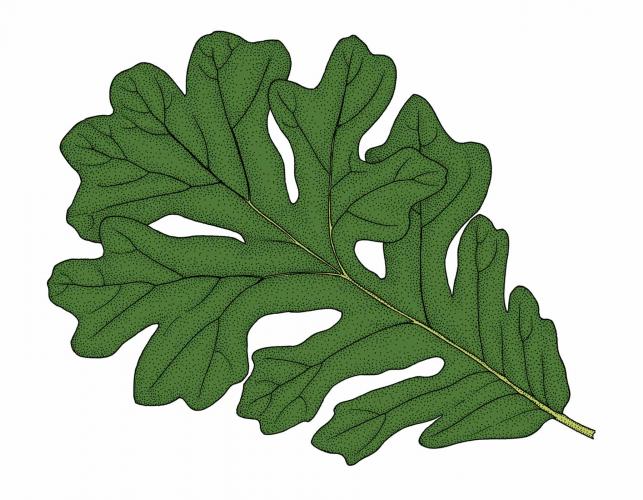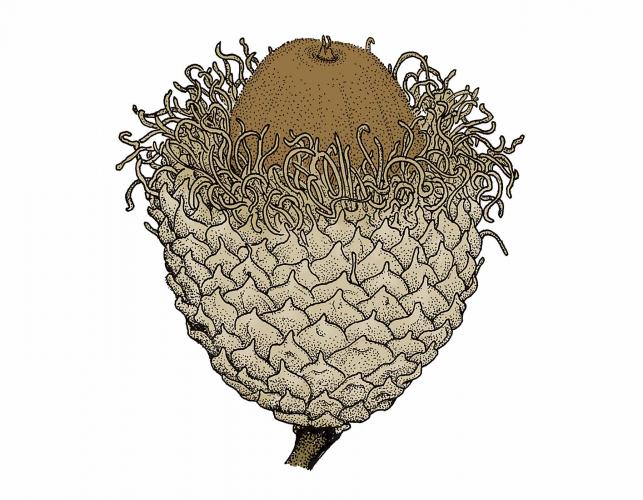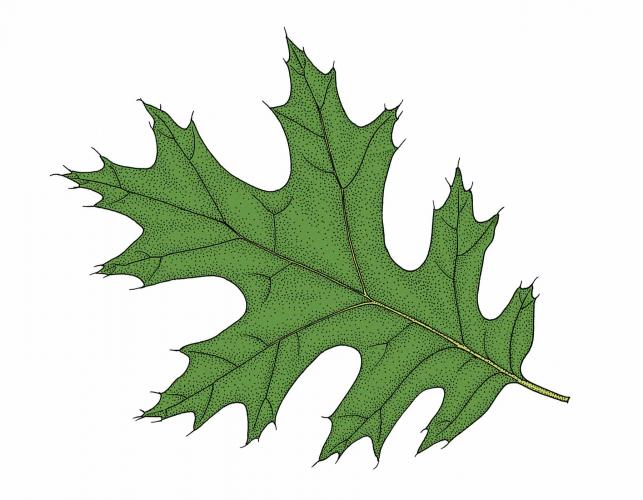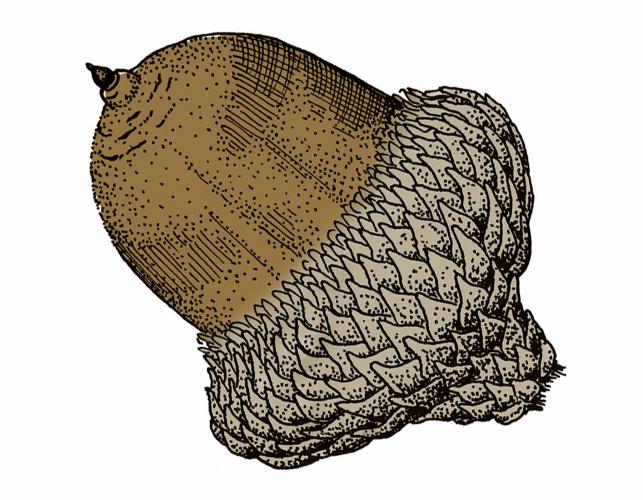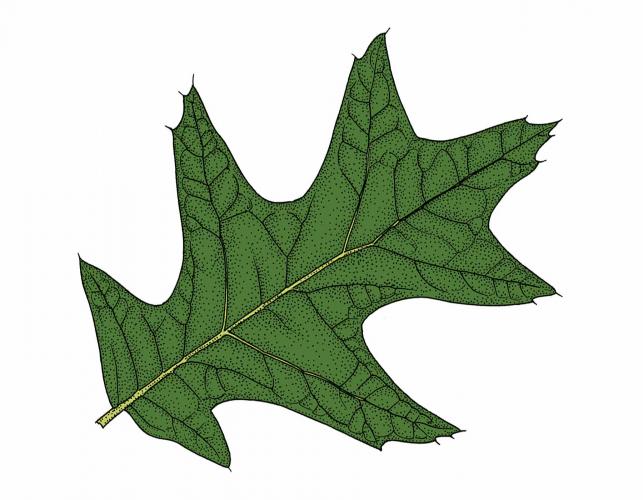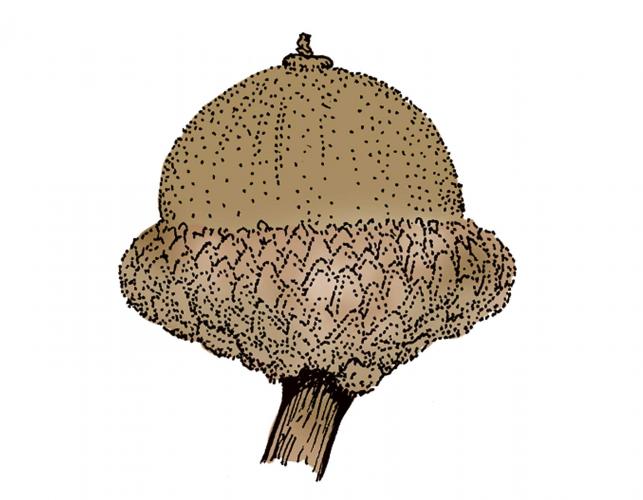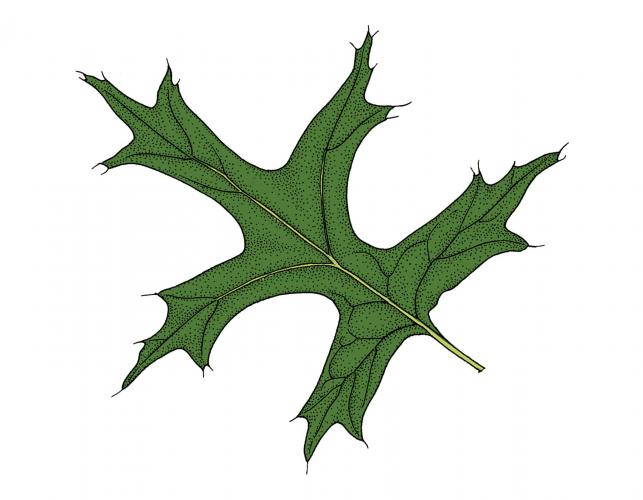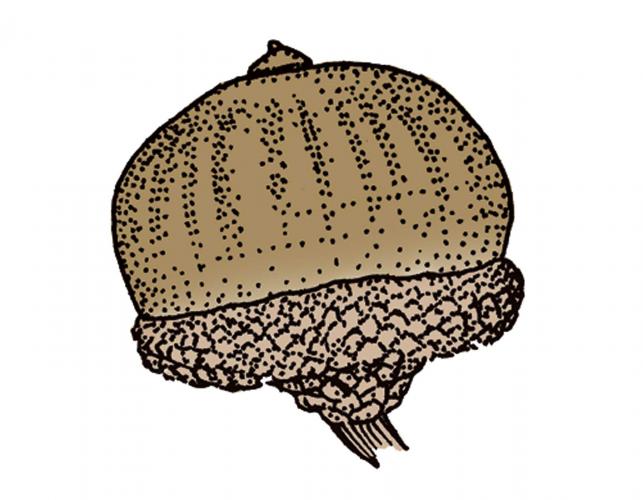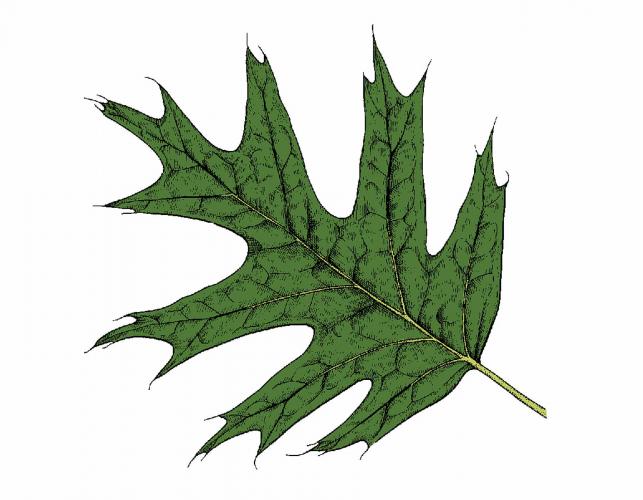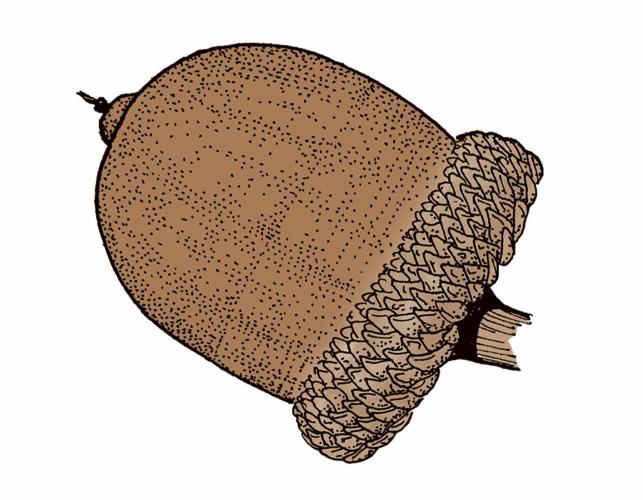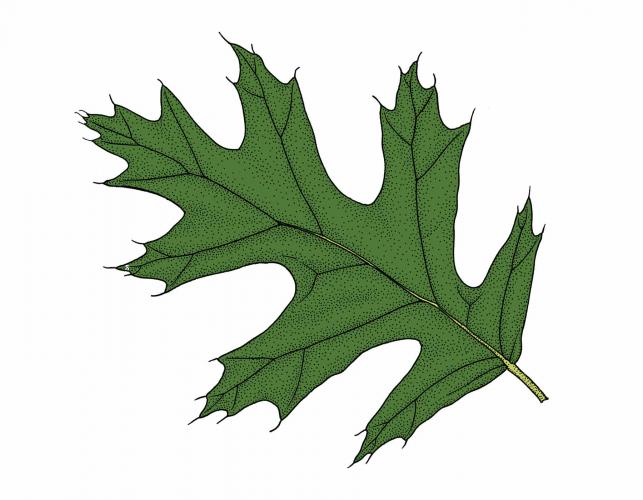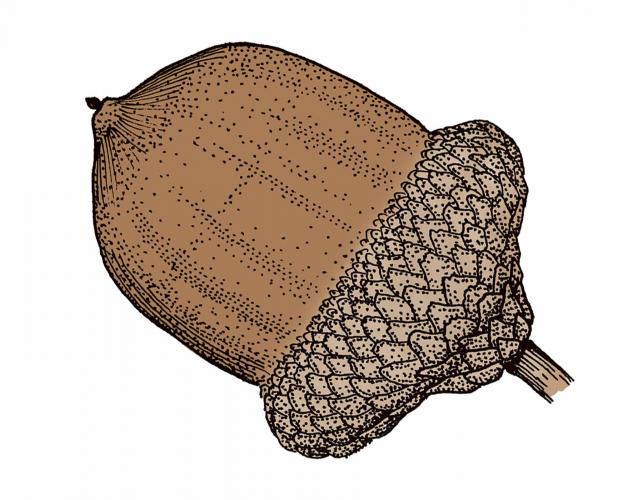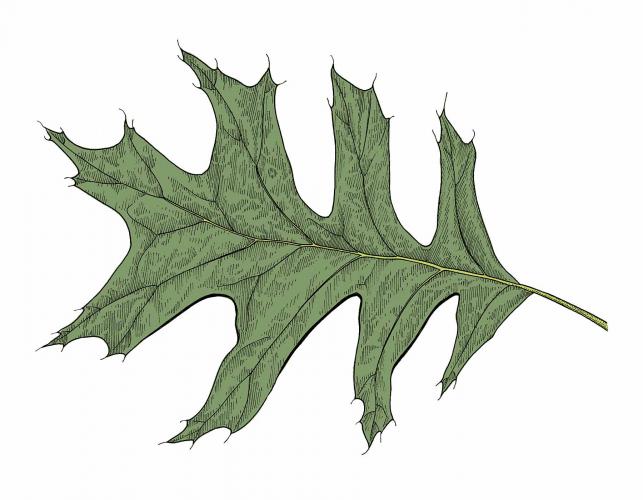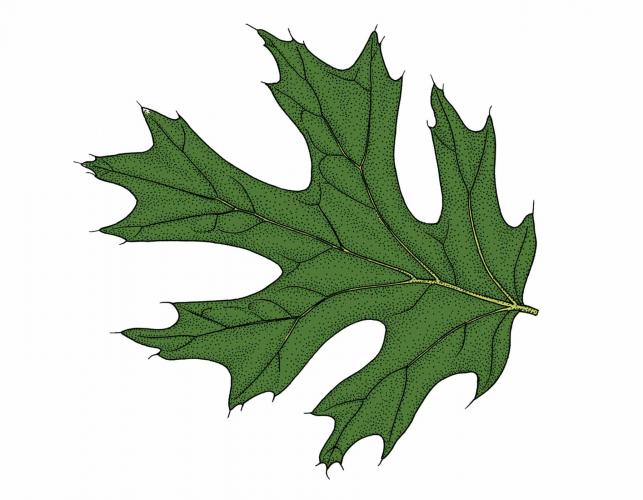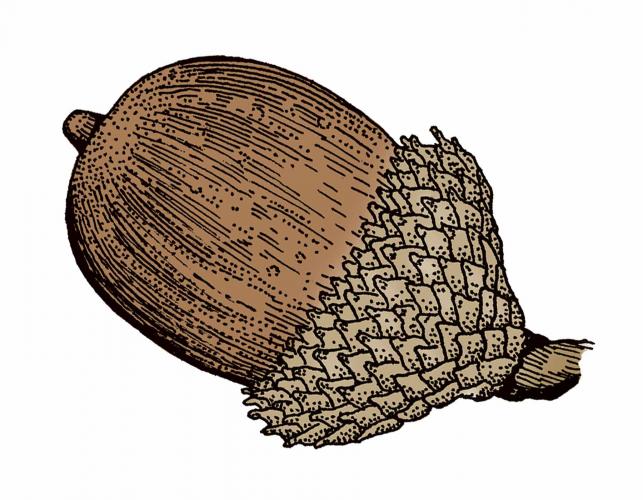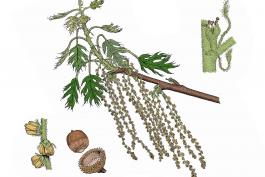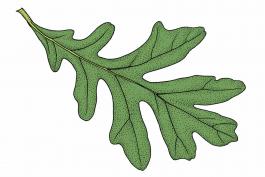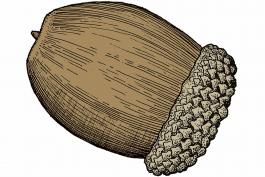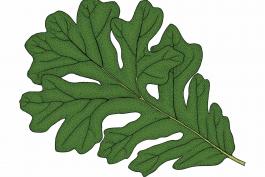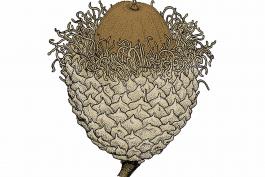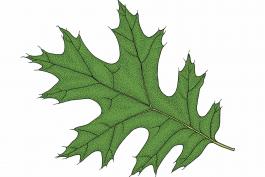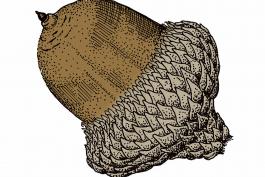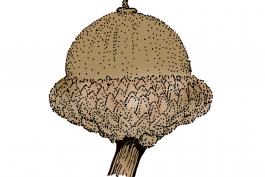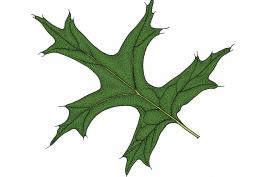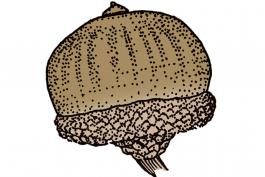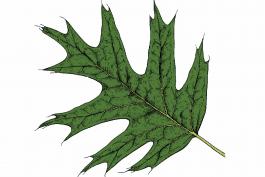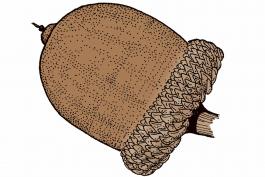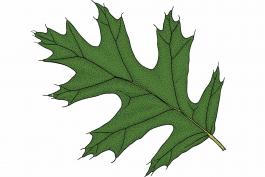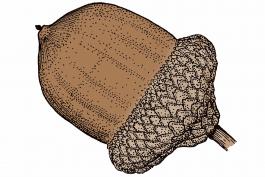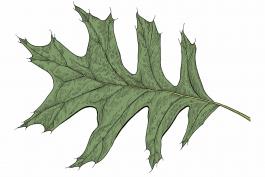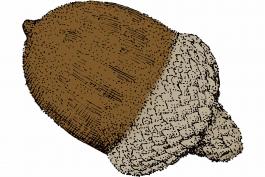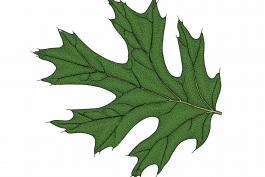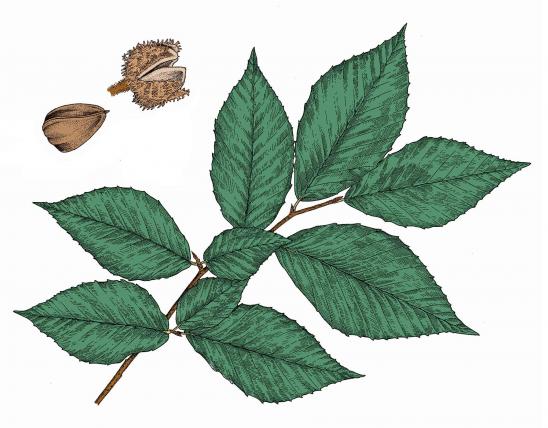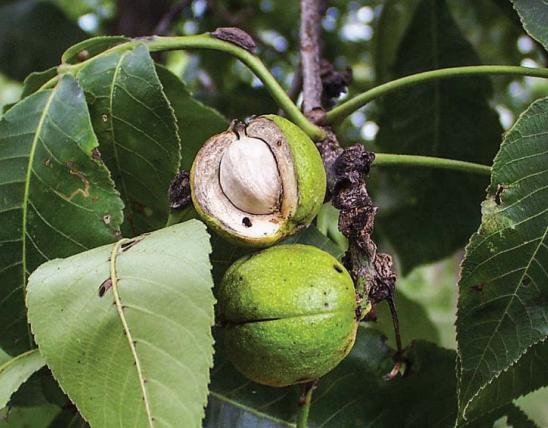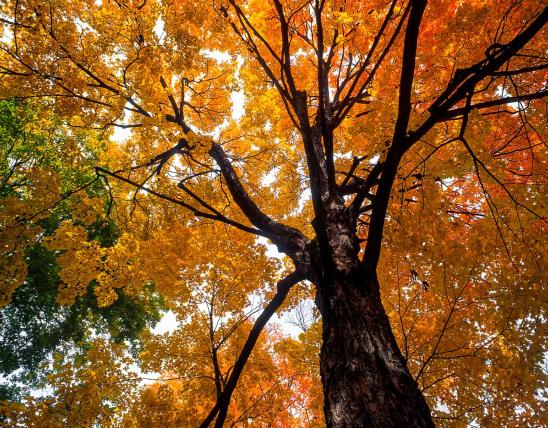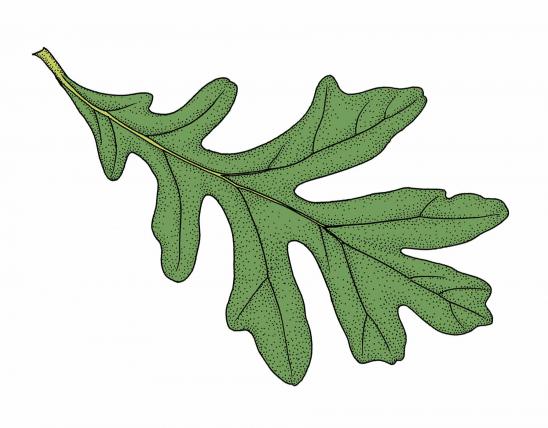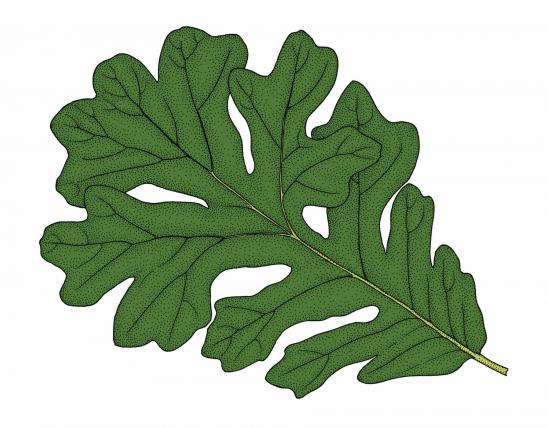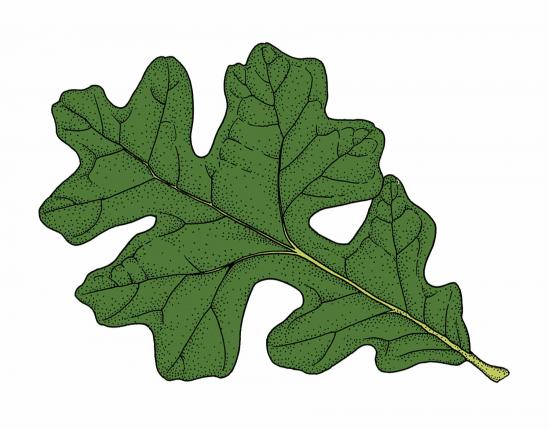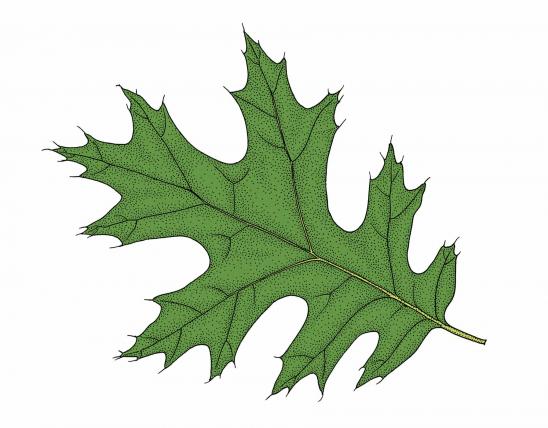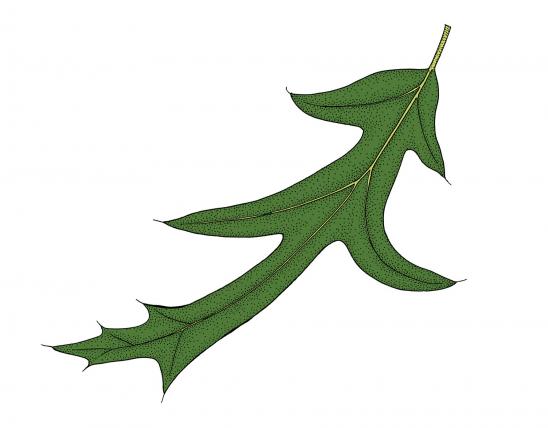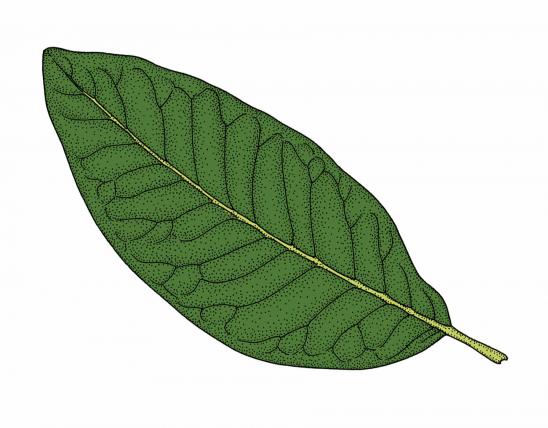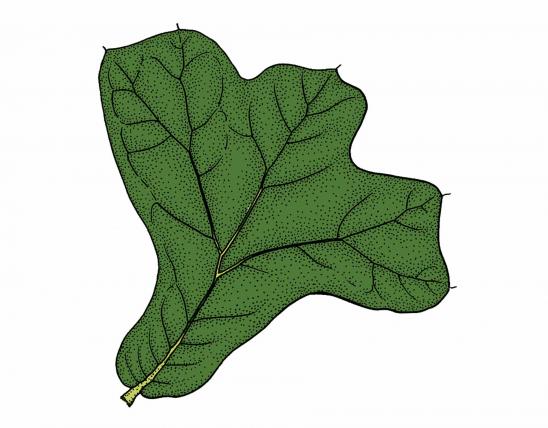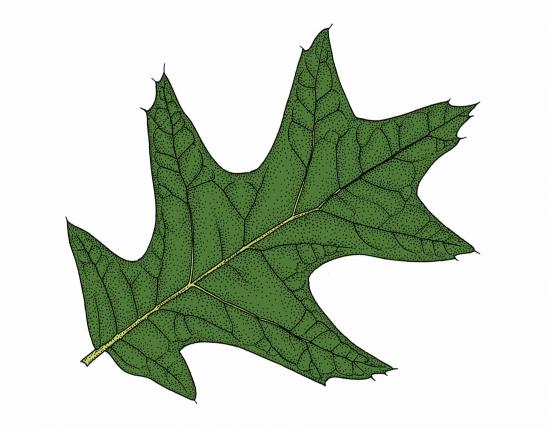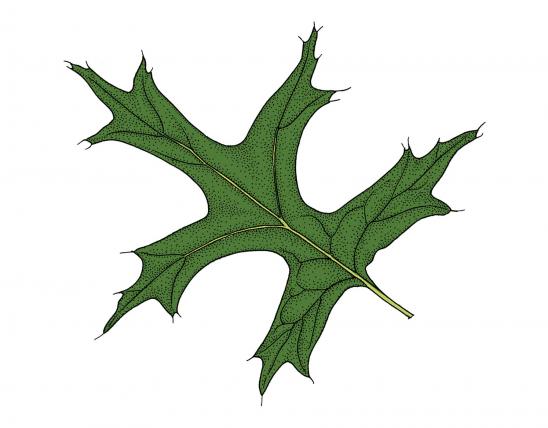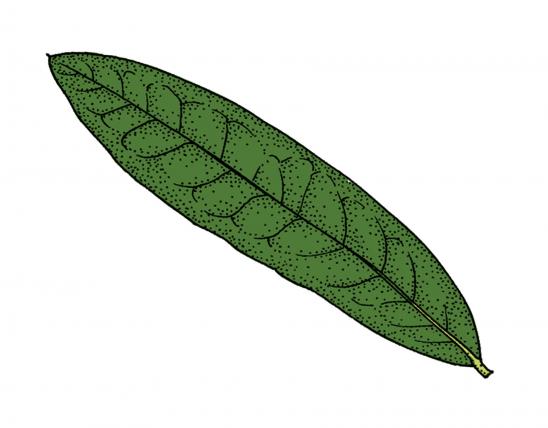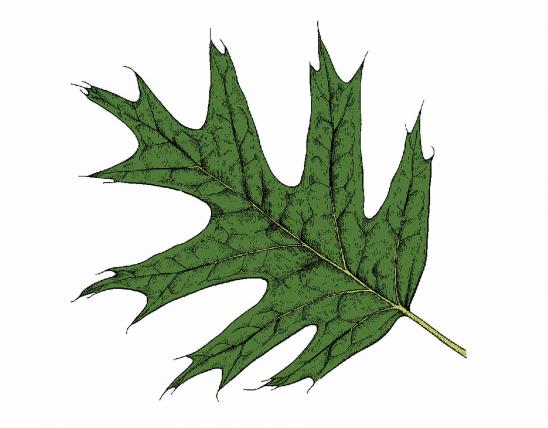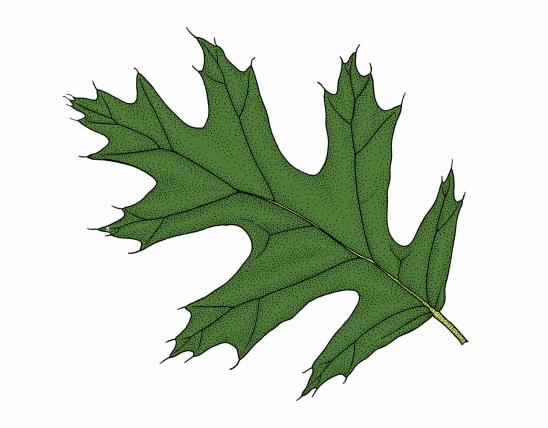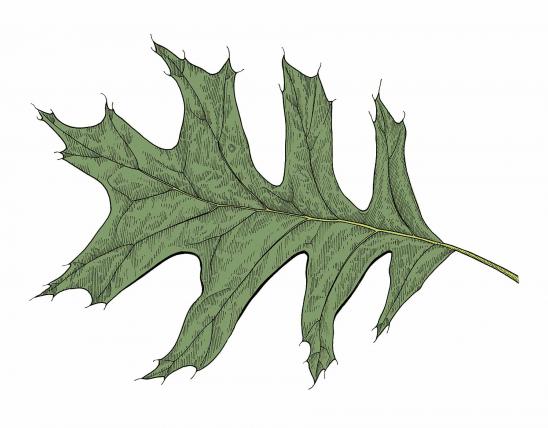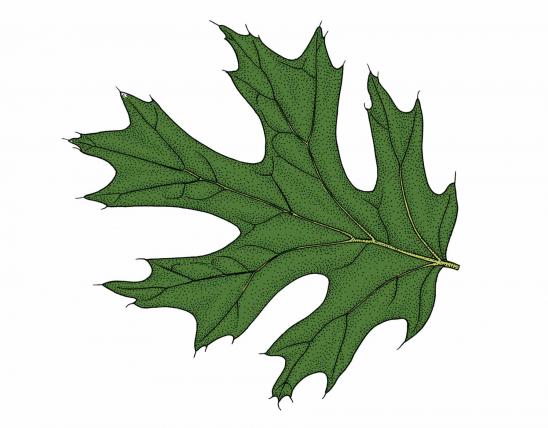
There are 22 species of oaks that grow native or are naturalized in Missouri. Also, more than 30 different oak hybrids (crosses between the various species) have been recorded in the state.
The oaks, which are related to beech, chestnut, and chinquapin, have several distinguishing characteristics. The fruit is the familiar acorn, a staple food for many species of wild animals. Leaves occur singly on alternate sides of the twig. Large pores are found in the springwood, and rays of wood radiate from the pith. Next to the acorn, the best identifying characteristic is the cluster or groups of buds found at the end of the twigs. The star-shaped pith of the twigs is characteristic also.
Botanists have separated the world’s oaks into 5 “sections” or subgenera (a level between genus and species). Missouri’s native oaks fall into 2 of those groups. Learning how to make this initial separation can simplify identification by automatically eliminating the species in the other group.
White Oaks, Section Quercus
The white oak group, called section Quercus (sometimes called Leucobalanus), is famous for having leaves with rounded lobes and “sweet” acorns that mature in a single year. The white oak (Q. alba) is the most famous species in this group (the group is named after it).
- Leaves are lobed or wavy along the edges, and the lobes and ends of the leaf are rounded and smooth (not spiky or bristle-tipped).
- The buds are rather rounded.
- The bark is light gray and rather flaky.
- Acorns in the white oak group provide “sweet mast”: the acorns mature in one year, are less bitter, and germinate in the fall.
- The wood cells of these trees are coated inside with a plastic-like substance called tyloses. This makes the wood waterproof (it swells well when soaked), which accounts for its use in barrels, buckets, and the hulls of ships. White oak wood is most durable.
- Globally, there are about 130 species in this section, ranging through North America, Central America, Europe, and Asia.
Missouri has 8 species in the white oak group:
- White oak (Q. alba)
- Swamp white oak (Q. bicolor)
- Overcup oak (Q. lyrata)
- Bur oak (burr oak, mossycup oak) (Q. macrocarpa)
- Swamp chestnut oak (basket oak, cow oak) (Q. michauxii)
- Chinkapin oak (Q. muehlenbergii)
- Dwarf chestnut oak (Q. prinoides)
- Post oak (Q. stellata)
Red or Black Oaks, Section Lobatae
The red oak group, section Lobatae (sometimes called Erythrobalanus), is famous for leaves with jagged, bristle-tipped teeth or lobes and “bitter” acorns that take two years to mature. The most famous representatives of this group are the different species of red oaks and black oak, Q. velutina.
- Leaves: Members of this section are characterized by the little bristles or spine-like tips at the edges and tips of their leaves: The major leaf veins project beyond the edges of the leaves as little bristles. The leaves may be lobed, toothed, or both, or they may be entire (unlobed and lacking teeth), as in the case of shingle, willow, and water oaks. Even in these latter cases, there is still a bristle at the tip of each leaf.
- The buds are pointed.
- The bark is dark gray to black, and it is rather rough and ridged rather than flaky.
- Acorns take two years to mature and they are bitter with tannin. They germinate in the spring.
- Globally, there are about 90 species in this section, ranging from North America to northern South America.
Missouri has 13 species in the red (or black) oak group:
- Scarlet oak (Q. coccinea)
- Northern pin oak (Hill’s oak, jack oak) (Q. ellipsoidalis)
- Spanish oak (southern red oak) (Q. falcata)
- Shingle oak (Q. imbricaria)
- Blackjack oak (Q. marilandica)
- Water oak (Q. nigra)
- Cherrybark oak (Q. pagoda)
- Pin oak (Q. palustris)
- Willow oak (Q. phellos)
- Northern red oak (Q. rubra)
- Shumard oak (Q. shumardii)
- Nuttall’s oak (Q. texana)
- Black oak (yellowbark oak) (Q. velutina)
Section Cerris (Not Native)
In addition to our two big native groups of oaks, Missouri has a single representative of section Cerris, one of the world’s other major groups of oak trees, that has become naturalized in our state. This species, the sawtooth oak (Q. acutissima), is native to Eurasia. It was introduced to our country and has become a popular ornamental landscaping tree. It is also sometimes grown in plantations to attract wildlife such as wild turkey. Some cultivars of this species are fast-growing and produce copious amounts of acorns at a rather young age; this species is potentially invasive. It occurs in roadside plantings, parks, disturbed areas, and — possibly problematically — native upland forests. Sawtooth oak is easily recognized by its combination of chestnut-like, unlobed leaves with sharp, bristle-tipped teeth (there are 10–18 bristles on each side), and acorn cups with conspicuously fringed or shaggy, triangular scales.
Other nonnative representatives of section Cerris are also common in cultivation, including European turkey oak (Q. cerris) and cork oak (Q. suber), but apparently only the sawtooth oak seems to escape into natural habitats, in part because it has been planted for wildlife.
Telling Red/Black Oaks from White Oaks
Leaves: Red oaks have bristle-tipped lobes or teeth on their leaves (or, in species whose leaves are both unlobed and untoothed, a bristle appears at least on the leaf tip). White oak leaves lack bristle tips and look rounded.
Bark: The bark of red oaks is often dark gray, brown, or occasionally black, and it is rough, hard, and ridged. The bark of white oaks is a lighter color and is scaly or flaky.
Acorns: The acorns of red oaks are bitter, and they mature in two seasons; thus there are two age groups of acorns on single twigs in summer, and there are immature acorns present on the tree during winter. White oak acorns are sweet, and they mature on the tree in one growing season, typically germinating immediately on falling from the tree; thus in summer there is only one age group of acorns present on the tree, and no immature acorns are present on the tree during winter.
Tips for Further ID
After learning to distinguish the two main sections of oaks, further identification usually involves noting details of leaves and acorns, such as:
- Leaves: numbers of lobes or bristles; shapes of lobes and sinuses (the space between lobes); overall leaf shape; amount, location, color, and shape of any hairs on the leaf; overall color of top and underside of leaf; and vein patterns. Note that leaf shape can vary greatly on a single tree, depending on position in the canopy or amount of shade/light, age of the leaf, time of year, age of the tree, and so on.
- Acorns: overall length and shape of nut; how much of the nut is covered by the cup; whether the cup is hairy or not; and patterns, textures, and shapes of cup scales.
- Habitat and range are also key identifiers for most Missouri oak species.
Similar species: Oaks are in the same family as beeches (Fagus spp.) and chestnuts and chinquapin (Castanea spp.). That’s why the family they all belong to (the Fagaceae) may be called the beech family, chestnut family, or oak family. The distinctive fruit type — the acorn — is a sure identifier for all in genus Fagus, the oaks.
You may have heard of various species of “live oaks,” named because they keep green leaves all year long (that is, they’re evergreen). These oaks are common in southern states that don’t experience snow and ice, and none are native in Missouri. All our native oaks are deciduous (drop leaves in fall).
Dwarf chinkapin oak is often shrub-sized, usually only reaching about 15 feet tall. Most of our species are medium to large trees, reaching 60 to 100 feet tall. White oak can reach 115 feet tall.
Statewide. Different species have different distribution patterns.
Habitat and Conservation
Oaks are the most important group of trees in Missouri, in both human and ecosystem value. They dominate most of the forests, woodlands, and savannas in the state, with their very presence essentially defining many of Missouri's habitat types.
Different oak species have different habitats they typically occupy. For example, some are most common in dry, rocky, upland Ozark woodlands, while others are most common in low, wet, bottomland or swampy areas, as in the Bootheel or along our big rivers.
Status
Status varies with species. Four of Missouri’s oaks are listed as Species of Conservation Concern. Northern pin oak (Q. ellipsoidalis) is critically imperiled within our borders; water oak and Nuttall’s oak (Q. nigra and Q. texana) are listed as imperiled; and dwarf chinkapin oak (Q. prinoides) is listed possibly vulnerable.
Human Connections
Most of our forest products industry, including flooring, barrel staves, pallets, and railroad ties, is based on the oaks. Oaks are also the most important hardwoods in North America. Only three other species or groups of trees — all conifers — exceed them nationally in lumber production. In Missouri, our oak saw timber volume of 8.3 billion board feet represents 63 percent of all our saw timber.
Much of our heritage and culture has been influenced by oaks because of their unique qualities, large size, old age, and sheer abundance. In ancient times, humans not only admired but actually worshipped oaks. Ships and empires were built with oak. Oaks live, too, in legend and history, often as individual trees: The old Oaken Bucket, the Charter Oak, and even Robin Hood’s Major Oak located in Sherwood Forest. It’s hard to overstate the worldwide importance of oaks historically and culturally.
Oaks produce high-quality hardwood lumber, which has been important for general construction, cabinet making and furniture making, veneer, pallets, and fenceposts.
White oak wood, with its ability to swell when soaked, has special uses for holding liquids and for ship building. This is one reason the English crown prized the extensive white oak forests of New England in the days of its global empire.
Also because of white oak wood’s ability to hold liquids, it is a favorite for making wooden barrels, including barrels used for aging fine wine and spirits such as bourbon whiskey.
Red oak lumber is important for flooring and other uses, but it is neither very durable nor waterproof. Red oak barrels can only be used to store dry materials. Red oak wood is also used as railroad crossties.
In prehistoric times, acorns were a staple food for humans in parts of the northern hemisphere. Acorns are quite nutritious but have high concentrations of tannins that must be removed by leaching before they are palatable. Generally, red/black oaks have higher tannin concentrations than white oaks and are more nutritious.
Ozark settlers relied on the wild woodland bounty of acorns for feeding their hogs.
Globally, there are many myths and stories associated with oaks, and oaks are sacred to many people. Oak trees figure into Ozark folklore in many ways. Some tales held that if oak trees budded out before ash trees in springtime, a wet summer would follow, and if the ash trees opened their buds first, there would be a late-summer drought. Another belief was that corn-planting time was when oak leaves had reached the size of squirrel’s ears. Other legends linked ghosts to certain trees (often, but not always, large oaks).
Oaks are important as shade trees and ornamentals in places where native trees have been left standing after building, but they are extremely vulnerable to construction injury. Every effort should be made to avoid severing roots, compacting the soil in the root zone, or smothering roots by earth fill.
Many species are difficult to transplant or to start in containers, so they are somewhat underutilized in the nursery trade. The young seedling puts most of its growth into a deep taproot. If this develops abnormally (as in a pot) or is cut off (for transplantation), the plant is sometimes unable to compensate and dies within a few years. Oaks are best planted in the place where they are to grow, but care must be taken to protect the cotyledons (nut meats) from squirrels, which may dig up the remains of the old nut and eat it.
By the way, oak leaves are not “too acid” to use as mulch. As oak leaves rot, they lose their slight acidity, and the oak leaf mold ends up alkaline. University of Missouri Extension advisors say to test your soil and add lime if necessary to raise the pH.
Ecosystem Connections
Acorns are a very important food for many wild mammals, including deer, squirrels, rabbits, raccoons, opossums, and mice; birds, including wild turkeys, northern bobwhite, wood ducks, mallards, woodpeckers, crows, and blue jays; and insects, including acorn weevils. In late fall and early winter, acorns may make up more than three-quarters of a white-tailed deer’s diet.
Oaks are a principal component of our native woodland and forest natural communities, and there are countless animals whose lives depend on oaks’ presence to survive. Birds and squirrels nest in trees. Spiders and a variety of insects pupate, hide, or overwinter in cracks in the bark.
Many upland species in the red/black oak group, especially in the Ozarks, began to experience dramatic die-offs in the late 1990s. This phenomenon, called “oak decline,” is a complex situation with several contributing causes. The stage was set by many trees already being old (they mainly live only 70 to 90 years) and weakened by environmental, climate, weather, and herbivore stresses, then being challenged by fungal diseases and a few particular types of insects that either bore under the bark or potentially defoliate the leaves.
Until about 100 years ago, woodlands of shortleaf pine used to dominate much of the south and central Ozarks, but after nearly all of those pine woodlands were cleared for lumber between 1880 and 1920, black, scarlet, and northern red oaks regrew in those areas instead of pines. With few pines left for reseeding, oaks have remained dominant, and the characteristics of the landscape, including soil chemistry, amount of exposed rock, presence of other types of plants, and presence of birds and other animals, have changed. The history of red oaks supplanting pines in these parts of the Ozarks is one reason why oak decline is happening — many of the oaks in this region began life in the years soon after the pines were cut.
Butterflies whose larvae eat oak leaves include several species of hairstreaks and many open-winged and dusky wing skippers. Moths whose larvae eat oak leaves include the waved sphinx, Polyphemus moth, buck moth, spiny oakworm moth, rosy maple moth, beloved underwing, the laugher, white-dotted prominent, one-spotted variant, scalloped sack-bearer, several types of slug caterpillar moths, black-waved flannel moth, and carpenter moth.
Oak gall wasps (family Cynipidae) insert their eggs into the leaves, twigs, buds, and other parts of oak trees. The plant responds by forming galls — enlarged, often rounded or inflated portions of leaves, twigs, and so on. The wasp larva feeds on plant materials formed within the gall. The various species create differently shaped galls in different parts of oaks. The galls are sometimes called oak apples or oak potatoes.
In many oaks, especially in members of the black oak group, the leaves are not totally deciduous (they don’t all fall off in the fall). Instead, the plants often retain their dried, brown leaves through the winter, especially on the lower branches. Other types of trees exhibit this phenomenon (called marcescence), too. Retaining dead leaves through winter may have a number of different adaptive advantages. The dry, unappetizing, loudly rattling leaves may deter herbivores such as deer from foraging on the twigs. Or, perhaps, keeping the leaves on the tree longer may facilitate their ability to add their nutrients back into the soil at the time the tree most needs those nutrients. Another idea is that during the winter, the leaves may capture additional snow and cause it to land and melt at the base of the tree, increasing the amount of water available to the roots.

